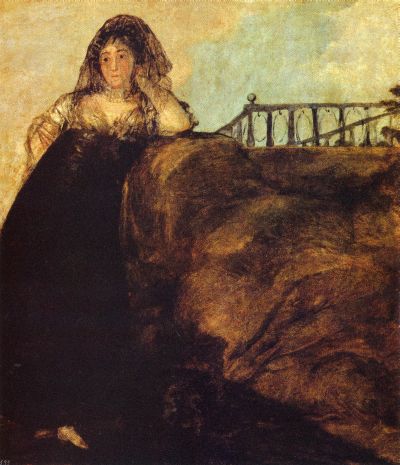Francisco de Goya
Francisco José de Goya y Lucientes (1746-1828) is one of the greatest Spanish artists of all times. His work includes portraits, history (especially war) scenes, religious subjects, and cartoons.
Goya has been the official court portrait painter and painted the portraits of Spanish royalty and nobility, but at the same time painted scenes from daily life and ordinary people.
The black paintings: Introduction
Towards the end of his life, Goya had become withdrawn, embittered, disillusioned. He was deaf, he had fallen out of grace with the royal court, his country was at war again. Between 1819 and 1823, when Goya was well in his 70s, he painted a series of fourteen or fifteen dark, disturbing, enigmatic images directly onto the plastered walls of two large rooms (one upstairs, one downstairs) in his country house. These paintings, that were later transferred to canvas, are now known as las pinturas negras, the black paintings.
The paintings
- A manola, doña Leocadia Zorilla
- Saturn devouring one of his children
- Judith and Holofernes
- The witches’ sabbath or the great he-goat
- Two friars
- Two old people eating
- Heads in a landscape
- Two men fighting with clubs
- The reading
- Two women and a man
- Pilgrimage to St. Isidore’s hermitage
- The fates
- Pilgrimage to St. Isidore’s well
- Asmodea
- Half-submerged dog
Probable location of the paintings in the two rooms of the Quinta del Sordo
A reconstruction of the plan of the two rooms in Goya’s country house, the Quinta del Sordo, where Goya created the black paintings.
Sources
This series of posts is based on the notes I made when I saw the black paintings in the Prado in 2003. While writing these posts I often consulted Las pinturas negras de Goya by José Manuel Arnaiz, and Goya: Work, life, dreams…
, by José Manuel Pita Andrade (transl. Evelyne Colchero).


His art is full of pain yet it attracts the viewer.
Pain, yes, but even more fear, I think. Most of the black paintings seem to deal with Goya’s fear of old age and his fear of death. The paintings do indeed attract a lot of viewers, they seem to be extremely popular, yet viewing them leaves you feeling dejected more than anything else.
Just to see these images on a screen let alone in the Flesh gives me an electrical charge of the sort that a person comes across a few times if they are very lucky in a lifetime.